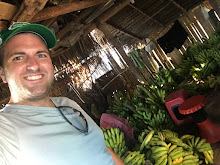Last night I made a roasted Amish chicken with a coriander, fennel, cumin, black pepper and salt, rub, turned out to be very delicious.
The first thing that I do when I roast a chicken is to; first wash down the surface that I am going to work on, get gloves and all my mies en place together. These items are
-Half hotel pan or a 10/12 roasting pan.
-Mesh rack
-Large Sautee pan
-Basting spoon
-1/2# butter
-1 Spanish onion
-1/2 head or garlic
-1/2 hand full of picked cilantro
-1 lemon
-Rub mix
-Towels
-Aluminum foil
-Butchering twine.
Next I wash the bird and pat it dry,
Now we trim up the bird by removing any of the unnecessary pieces. Look for the little nub, located at the back of the bird by the large opening; you can cut it off with scissors or a knife, the other part I usually clean up is the neck area, and the wishbone. For the wishbone, I like to slice around it before while it is still raw, then pack a half clove of garlic in each pocket made by slicing around the bone, then pulling on the excess skin with light jerking motions it will tighten up the breast, and slice off a thumbs thickness of the left over skin. Now season the bird generously, being sure to coat the entire chicken in every crevasse, even inside. Chop the onions and left over garlic in large chunks, skin on the garlic is fine no need to peel it. Pack these into the bird and close the hole with a half a lemon. Now tie the bird by making a large circle of twine tied together and loop it around the extremities. Once the wings have been secured, making a large X across the back towards the rear, loop the legs one by one going around the right leg in a clockwise motion and the left in a counter clockwise motion, pull the rope tight and loop around them both will complete the process. Tie and cut the remaining twine. Get the large pan smoking hot but over medium, medium high heat and lay the bird on its side. Cooks for about 3 minutes until there shows caramelization has developed, then flip the bird to the opposing side and continue to reach the said goal, once that had been achieved then onto the breast and repeat the same process. Then put the bird into the roasting pan fitted with the rack. Put remaining onion and garlic over the carcass and lob hunks of butter into the pan, being sure to put 2 or 3 in behind the lemon. Close up the roasting pan and cut an opening about 8 inches long down the top of the foil. Put the pan into a preheated oven at 350 degrees. Cook for 45 min, baste the bird several time, turn the heat up to 375 and cook for about 1 hr more basting every so often.
I hope you can follow all of that!
